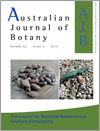Australian Journal of Botany
Volume 62
Number 2 2014
Cape York Peninsula has a rich diversity of vegetation types including rainforest, woodlands and grasslands. The Peninsula contains a mix of recently evolved plants and those with ancient relationships back into the Cenozoic. It is significant because its plants demonstrate the development of the Australian vegetation from rainforest to grassland.
Eucalyptus cordata is a rare species confined to south-eastern Tasmania, where its growth habit ranges from a stunted, multi-stemmed shrub to tall forest trees in small, isolated populations. With DNA markers, we found that its evolutionary history was closely associated with the endangered E. morrisbyi and that whereas some populations of E. cordata are relicts of the distant past, others showed evidence of recent evolution (e.g. subspecies quadrangulosa). The species appears to be genetically healthy with normal levels of genetic diversity.
Legume species are used for restoration of degraded areas. We compared the reserve degradation during germination of two tropical seed legumes used in restoration. Although with different reserve tissues and ecological behaviour, starch is not used during germination and early seedling growth in both species.
Plantago albicans is a perennial herbaceous plant widely distributed throughout the Mediterranean region. Presence of mucilage on P. albicans seeds increased germination percentages and germination rate at all temperatures tested. Increased osmotic stress and salinity caused a decrease in germination percentages and delayed germination rate. The degree of salt tolerance shown by this species may be sufficient to permit seed germination at the levels of salinity found in the soils of its natural habitat.
One of the most interesting topics in ecology is how plants are able to live in extreme habitats. By analysing leaf and stem characters of 12 Asteraceae, we were able to circumscribe four groups of plants with peculiar adaptations to the Cerrado Domain and the open areas of the Atlantic Forest. This investigation provides important contributions to the understanding of the responses of Lychnophorinae species to different environments.
Despite the iconic presence of the boab (Adansonia gregorii) in the Kimberley region of northwestern Australia, little is known of its evolutionary history. We examined genetic variation across the region and found weak but significant divergence between east and west and between coastal and inland populations; significant ancient population size reduction and significant gene flow were also revealed.




